June 3 - 9, 2018: Issue 362
Collecting Buttons
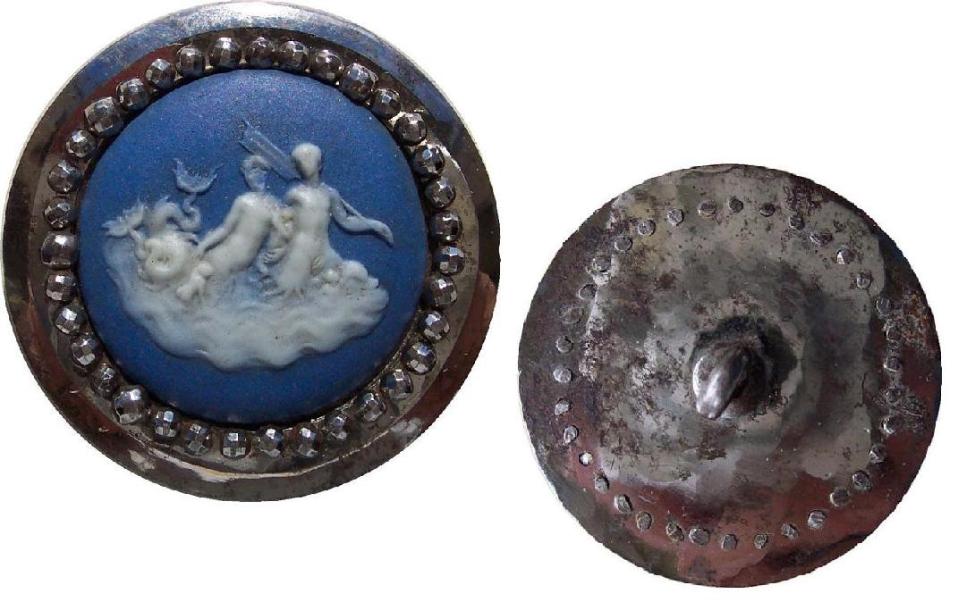
Collecting Buttons
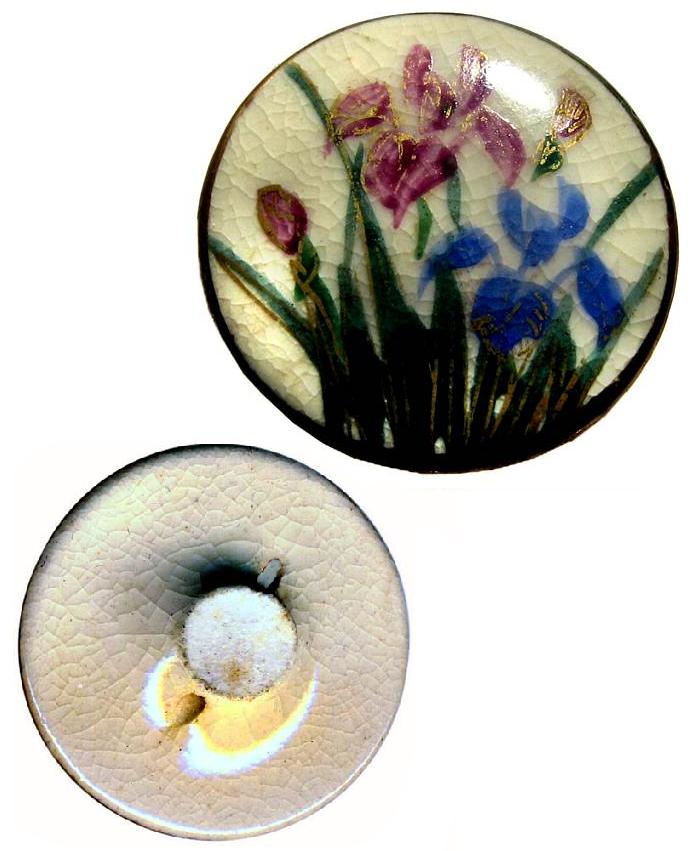
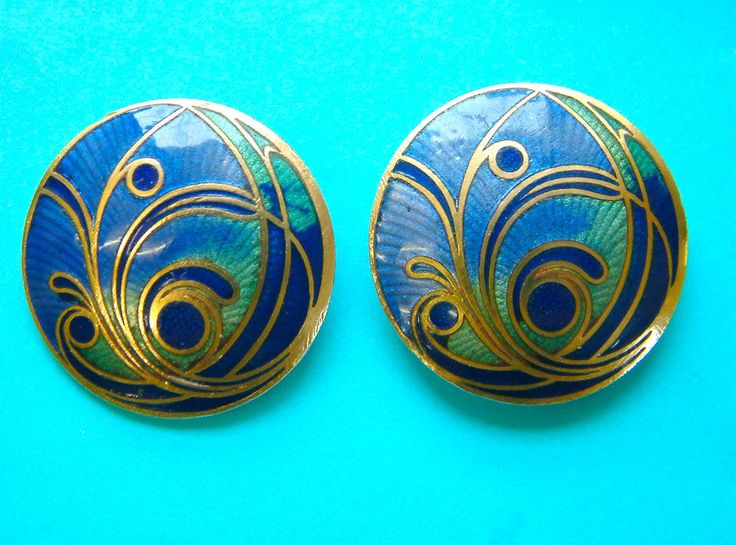
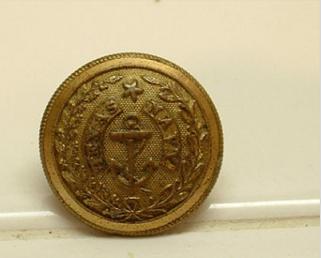 Buttons gleaned from clothing worn by celebrities or sports stars can also be quite valuable if the provenance is verifiable. Buying a piece of clothing in poor condition at auction might not be such a bad proposition if it contains a number of buttons and scraps of fabric that can be salvaged along with them. These can be sold individually to collectors who would relish owning a little piece of pop culture or sports history. [3.]
Buttons gleaned from clothing worn by celebrities or sports stars can also be quite valuable if the provenance is verifiable. Buying a piece of clothing in poor condition at auction might not be such a bad proposition if it contains a number of buttons and scraps of fabric that can be salvaged along with them. These can be sold individually to collectors who would relish owning a little piece of pop culture or sports history. [3.]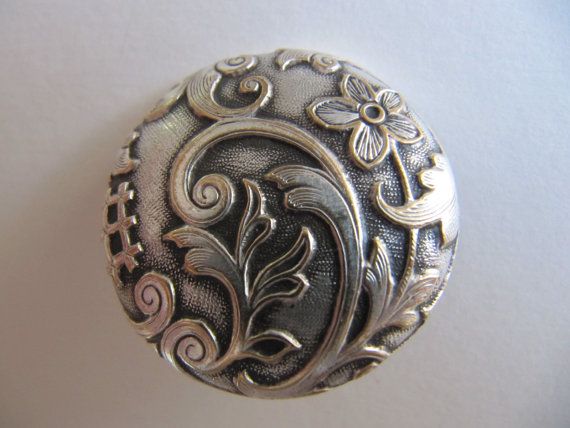
References
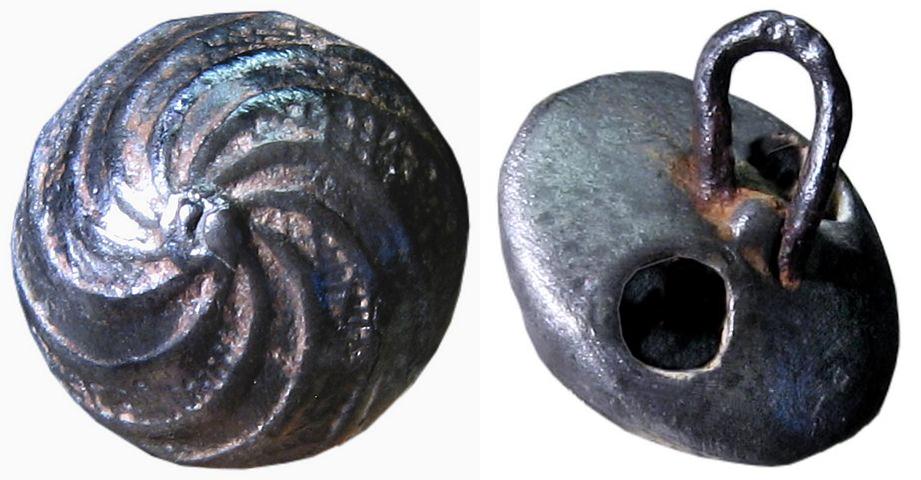
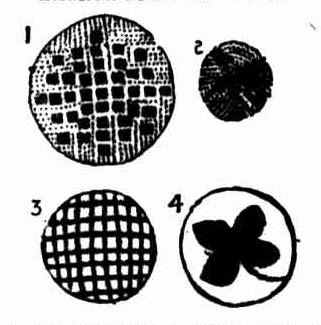 Embroidered buttons are the very latest and daintiest of dress accessories. They are quickly worked, and will make a charming present for the 'something new' to be worn on the first day of the year. AH sorts of materials are used for the background of these buttons, silk, satin, or linen, according to the fabric of the dress they are to adorn. They arc not of the dress material, but of appropriate texture. The embroidery Is In silk or linen floss. The design Is stamped upon the material, and the embroidery is completed, after which the pieces are mounted on wooden button moulds. These moulds are sold by drapers In England, but may not yet be obtainable here, but flat linen buttons, or rounded smooth ones, could be used. The edges of the material could be drawn tightly together at the back of the button and secured with thread, and the unnecessary material cut away. Designs No. 1 and 2 are cross stitches on canvas, carried out In green silk. No. S Is a blue linen background, worked in rich brown conching stitch, the brown forming tiny squares, which are caught at the Intersection with gold thread. Care must be taken to see that the stitches are at the same angle, and of equal size. The remaining button is a four-leaved clover, In green, upon white satin, the stalk curving to the edge. Violets, single daisies, or butter-cups also look well. EMBROIDERED BUTTONS. (1905, January 7). The Inverell Times (NSW : 1899 - 1954), p. 3. Retrieved from http://nla.gov.au/nla.news-article184679803
Embroidered buttons are the very latest and daintiest of dress accessories. They are quickly worked, and will make a charming present for the 'something new' to be worn on the first day of the year. AH sorts of materials are used for the background of these buttons, silk, satin, or linen, according to the fabric of the dress they are to adorn. They arc not of the dress material, but of appropriate texture. The embroidery Is In silk or linen floss. The design Is stamped upon the material, and the embroidery is completed, after which the pieces are mounted on wooden button moulds. These moulds are sold by drapers In England, but may not yet be obtainable here, but flat linen buttons, or rounded smooth ones, could be used. The edges of the material could be drawn tightly together at the back of the button and secured with thread, and the unnecessary material cut away. Designs No. 1 and 2 are cross stitches on canvas, carried out In green silk. No. S Is a blue linen background, worked in rich brown conching stitch, the brown forming tiny squares, which are caught at the Intersection with gold thread. Care must be taken to see that the stitches are at the same angle, and of equal size. The remaining button is a four-leaved clover, In green, upon white satin, the stalk curving to the edge. Violets, single daisies, or butter-cups also look well. EMBROIDERED BUTTONS. (1905, January 7). The Inverell Times (NSW : 1899 - 1954), p. 3. Retrieved from http://nla.gov.au/nla.news-article184679803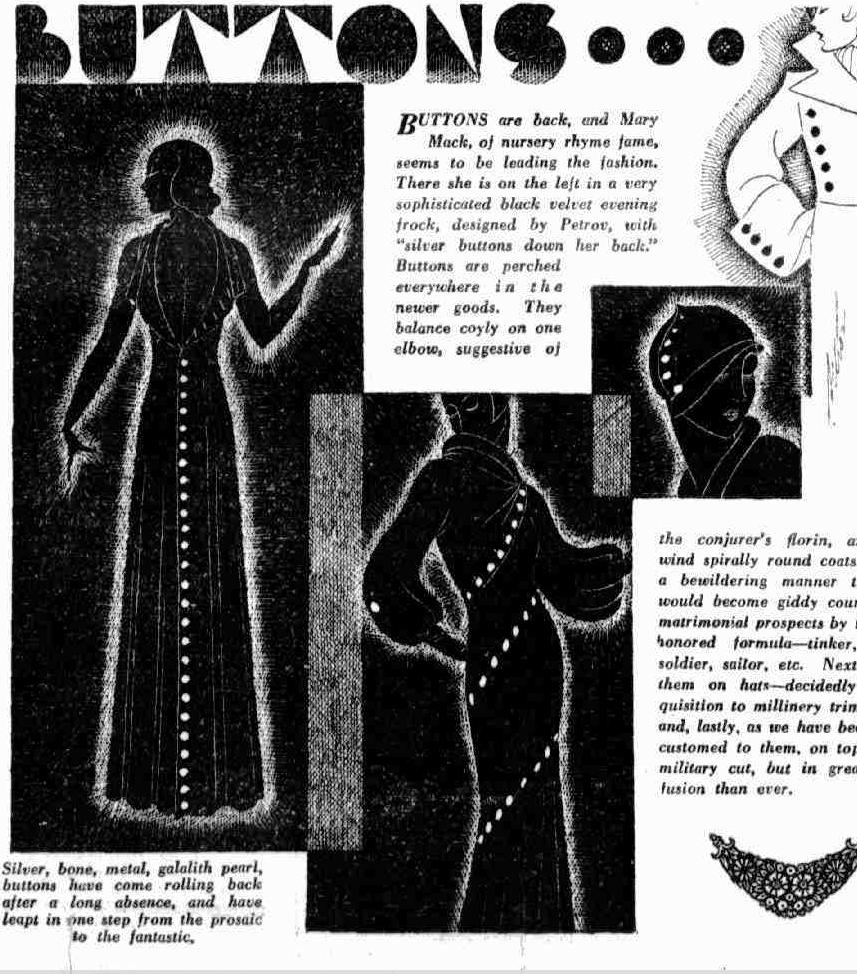
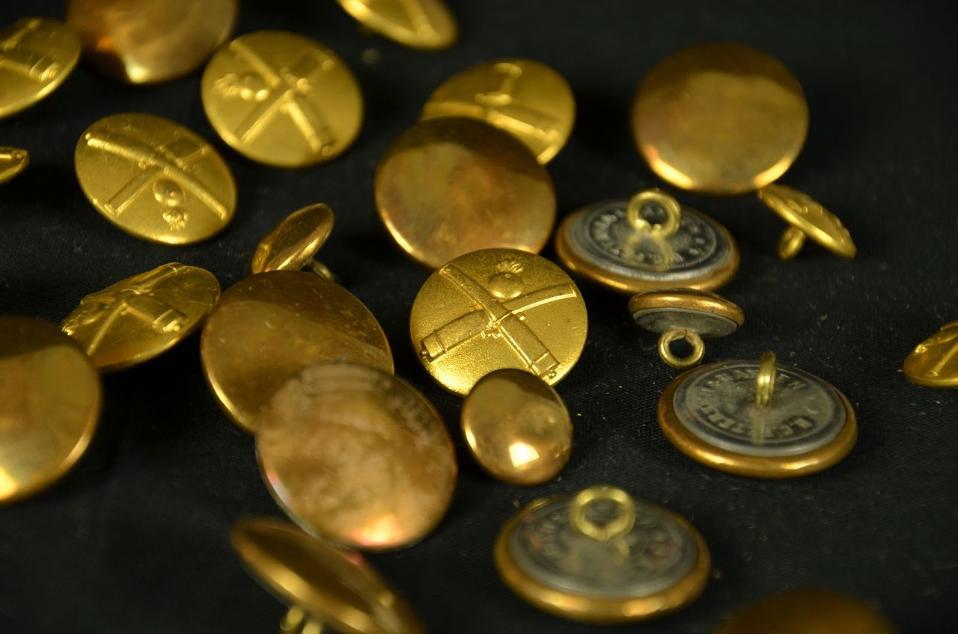
Previous Collectors Corner pages:
Blacksmiths and Tinsmiths Nylon Stockings Poster Art Furphy's Water Cart Mousehole Anvil Sapphire One Armed Bandit Gould's 1840 Single and Compound Microscope Tibetan Thangka Wheel Of Life Painting Cast Iron Seats Mabel Lucie Atwell Prints The Customs of Traditional Dining by Hans and Jenny Carlborg Albert Collins Landscape Boomerang Harmonicas Drinking: 18th Century Style Part I by H&J Carlborg Drinking 18th Century Style Part II by H&J Carlborg Fleece Shears Wood Case Crank Telephone 1803 Timepeice Vintage Guitars Milestones No.38 Rolls Royce Motor Oiler Christmas Postcards Seashells McCormick-Deering Horse Drawn Mower Rope Making Machine Marilyn Monroe 1955 Calendar Stubbie Holders Hill's Hoist Akubra Hat Fowler's Bottling Kit The Bold Autographed Script Fishing Tackle Arnotts Biscuit Tins Comic Books Silver Opium Pipe Mrs Beetons Book Souvenir Teaspoons Bendigo Pottery Gianelli Figurines Key Fobs Model Aircraft-static Porcelain Slippers Wagon Wheels Rhys Williams Painting Chinese Guardian Lions Australian Halfpenny Bud Vases Rolling Stones Still Life LP Autographed WL1895 Thinking Monkey Estee Lauder Ginger Jar Reel Mowers Surf Reels Millers Car Collection Hilton Lingerie - Slips Miniature Books of Verse - A Romantic Tradition REGA Pouring Can R O Dunlop - Sailing At Itchenor Painting Morning Shadows by C Dudley Wood The Father of Santa Claus - Xmas 2012 HMS Penguin Anchor at RPAYC - Newport SS Birubi Mast at RMYC - Broken Bay Helen B Stirling Ship's Wheel at Club Palm Beach Woomeras HMSEndeavour Replica Cannon at RPAYC The Doug Crane Classic Handmade Double Blade Paddle HMS Bounty Wooden Ship Model Collecting Ladies - Ferdinand Von Mueller and Women Botanical Artists Australian Bark Art Chinese Ginger Jars Hand Plough and Jump Stump Plough - Australian Inventions Frank Clune Books Frederick Metters - Stoves, Windmills, Iron Monger Trinket Boxes 1933 Wormald Simplex Fire Extinguisher is Pure Brass Chapman 'Pup' Maine Engines - Chapman and Sherack The Beach Ball Figureheads Salty Wooden Personifications of Vessels Binnacle at RMYC The Australian Florin - Worth More Than 20 Cents to Collectors Weathervanes; For Those Passionate About Seeing Which Way the Wind Blows Her Majesty's Theatre 1962 Programme - Luisillo and his Spanish Dance Theatre Cooper's Sheep Shower Enamel Sign and Simpson's and Sons of Adelaide Jolly Drover Sugar Bowl and English Pottery A Means to Gaze into the Past Chief Joseph and Edward S Curtis; His Images of Native Americans an Inestimable Record of Images and Portrait Photographs His Masters Voice, Old 78's and Australia's Love of Music Jack Spurlings 'Tamar' Picture 1923 Resch's Beer Art - A Reflection of Australiana Now Worth Thousands The Compleat Angler - Izaak Walton's Discourse Inspires Generations of Fishers Portable Ice-Boxes and Coolers How Many Claim This Invention as Theirs? Malley's and Sons Ltd. - A Munificent Australian Family Company Vintage Paddles and Gigs Nautical Memorabilia The Crinoline - a 550 Year Old Fashion B.B. King - King of the Blues Goes Home: a Timely look into Photographs and Autographs and Being Buyer Aware Deep Down Among the Coral - By Christopher Corr - A Limited Edition Print in Celebration of the seventy fifth anniversary of QANTAS Airways Old Chinese Rice Bowls for Marriage: Worth More Than You Think... Commanderie St. John: An Ancient Wine - From 1927 with Lineage to Cyprus in 1210/92 and Methods of Production to Greece in 800 B.C. Pittwater Regatta Air Race Trophies: from 1934 and 1935 and The Pilot Who Saved William Hughes Vintage Brass Mortar and Pestle 1958 Bedford 'D' Truck and GM Holden Australian Made Car Bodies Heart Padlock Charm Bracelets for Newborns: A Golden Tradition Marvellous Marbles: An All Ages Preoccupation for Collectors Antique Silver Fish Servers: Artisans Past Tuckfield's Bird Cards: to Swap or Collect Joseph Lyddy – O.B.B. Dubbin Boot Polish Vintage Wooden Tennis Racquets: A Collectors Item As Popular As Summer Australian Trade Tokens Record Enriching Colonial Histories: the Cascade Shilling First Art Form To Record 'Tasmania' And Kangaroos Australian Vinyl Singles of the 1950's and 1960's Dicken's The Old Curiosity Shop bought at The Old Curiosity Shop Pear's Soap: Artworks For The Masses Collecting Vintage Photographs: Early Tasmanian Photographer - J W Beattie Cyclops Vintage Toys Year Dated Beer Bottles Found In The Estuary Adjacent To Taylors Point - Roger Wickins Collecting Matchboxes: A Great Way To Explore History And Art Black Bakelite Telephone: Early Pittwater Phone Numbers Butter Churns and Milk Separators: Early Pittwater Dairies F100 Ford truck: 1977 model